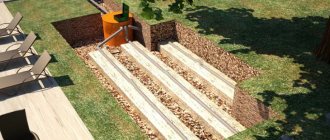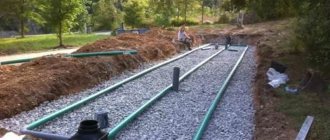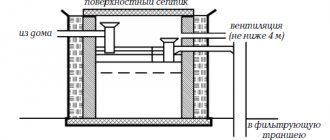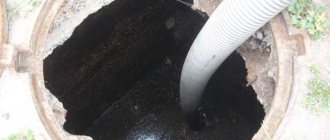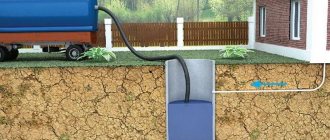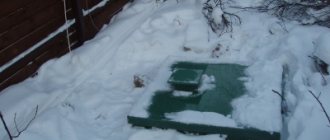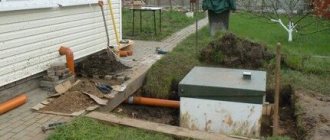Real estate
00:00, 19.04.2021 15
We consider the three most popular ways to drain water from a septic tank - a filter well, filtration fields and drainage tunnels
Photo: ibud.ua
Regardless of what septic tank is installed on your site, the clarified (purified in the septic tank) water will need to be disposed of somewhere. It should not be dumped into ponds or ditches unless you have an aeration plant that disinfects the drains. The solution is ground filtration as a method of water purification. There are three popular ground filtration systems among our homeowners, and we propose to talk about them today.
Filtration field as part of the sewer system
Without the main part that performs the initial processing of sewage waste, that is, a septic tank, the filtration field is not used, since its purpose is to further purify the already purified liquid. To make it clearer, let's look at how VOC works.
The cleaning process begins in the storage tank, where sewage is divided into different fractions: solid mineral waste falls out in the form of sediment, fat floats and forms a film, and some substances remain in the water as suspension. If air supply is not provided, the process of decomposition of some of the waste occurs due to the activity of anaerobic bacteria.
Scheme of a sewerage system consisting of an internal sewerage system, a two-chamber septic tank with an air supply (storage + aerobic compartment), a collector and a filtration field
Then the liquid flows into the next compartment, equipped with ventilation, where aerobic microorganisms process wastewater. They form activated sludge, which can later be used as fertilizer. The result of two-stage purification is a slightly cloudy liquid that is not yet suitable for use.
It turns into process water or simply ends up in the ground (ditch, pond) after undergoing post-treatment, which is carried out in the following way:
- on the filtration field;
- in the infiltrator;
- directly in the ground;
- in the filter well.
A typical multi-stage system, which has dozens of design options, is good because it effectively cleans sewage waste, reduces cooperation with sewer trucks to a minimum and keeps the ecology of the garden plot clean. Now let’s take a closer look at the design of the filtration field.
Selection of treatment plant
If we compare treatment facilities, it is noticeable that the filtration field occupies the golden mean - more reliable than a drainage well, but at the same time cheaper and simpler than a tunnel with cassettes. Basic data is shown in the table:
| Type of drainage structure | Basic materials | Advantages | Flaws | Device requirements: |
| Filter well | Bricks, rings, tires | Simple design, inexpensive | Unpleasant odor, poor cleaning quality, small volumes | Requires about 1 m2 away from the house and well |
| Aeration field | Pipes, crushed stone | Simple design, ability to schedule treatment of any volume of wastewater | Requires a large area, approximately once every 5 years of reconstruction | · sand filter below soil freezing; · pipes 1 m above the groundwater level; · need for ventilation |
| Drainage tunnel | Infiltrator cassettes | Robust, durable, high cleaning speed | High cost of construction if you buy industrial infiltrators | It does not take up a separate space; you can arrange any structures, flower beds, etc. on top. |
Expert opinion
Evgeny Burilov
Expert on sewerage and water supply
The aeration field does not work on its own, but is an addition to any septic tank. The sharing scheme has dozens of options. The use of the design highly effectively cleans wastewater, almost eliminates the need for sewer trucks, and preserves the purity of the surrounding nature.
PF design features
A filtration field is a relatively large area of land where secondary purification of liquid occurs.
This cleaning method is exclusively biological, natural in nature, and its value is in saving money (no need to buy additional devices or filters).
The size of the PF depends on the area of free territory and the landscape features of the garden plot. If there is not enough space, instead of the PF, an absorption well is installed, which also filters the liquid before it enters the ground
A typical filtration field design is a system of parallel laid drainage pipes (drains), which extend from the collector and are placed at regular intervals in ditches with a thick sand and gravel layer.
Previously, asbestos-cement pipes were used, but now there is a more reliable and economical option - plastic drains. A prerequisite is the presence of ventilation (vertically installed risers that provide oxygen access to the pipes).
The design of the system is aimed at ensuring that the liquid is evenly distributed over the designated area and has a maximum degree of purification, so there are several important points:
- distance between drains – 1.5 m;
- length of drainage pipes – no more than 20 m;
- pipe diameter – 0.11 m;
- intervals between ventilation risers – no more than 4 m;
- the height of the risers above ground level is at least 0.5 m.
To allow natural movement of liquid, the pipes have a slope of 2 cm/m. Each drain is surrounded by a filtering “cushion” of sand and pebbles (crushed stone, gravel), and is also protected from soil ingress by geofabric.
One of the complex variants of the device: after cleaning in the filtration field, the water enters a storage well, from where it is pumped out using a pump. Its further path is into a pond or ditch, as well as to the surface for irrigation and technical needs.
There is one condition, without which the installation of a septic tank with a filtration field is impractical. Special permeability properties of the soil are required, that is, on loose coarse and fine clastic soils that do not have connections between particles, it is possible to construct a post-treatment system, but dense clay soils, the particles of which are connected in a consolidated manner, are not suitable for this.
Types of infiltrators for septic tanks
There are many options for clarified water purification systems:
For sandy or peat soil, as well as variable groundwater level - a 400 mm plastic well, which will be used to drain wastewater,
With high and variable groundwater level, sand, peat or loam - a well made of concrete rings,
For low groundwater level and soil types such as sand and peat - buried drainage under the septic tank,
Under the same conditions, you can use gravity drainage into a 400 mm plastic well,
With low and variable groundwater level, sand, loam or peat - a well made of concrete rings for drainage by gravity.
Typical device diagram
Whatever the general dimensions of the filtration field, its design consists of the following parts:
- collector (control well, distribution well);
- networks of plastic drains (drainage pipes with holes);
- ventilation risers;
- filter pad.
Traditionally, the drainage layer is made of sand and gravel (crushed stone, pebbles). Geotextiles are used to protect drains. A sewer system with PF looks like this:
Pay attention to the thickness of the drainage pad. The minimum indicator is considered to be a total thickness of 1 m; in this diagram it is greater: crushed stone - 0.3-0.4 m, sand - 0.8-1 m
When building a filtration field with your own hands, it is not necessary to build the collector yourself - you can find plastic sewer containers of the required volume on sale.
They often do without a distribution well, connecting directly the septic tank and the pipe system - but this is convenient for small-sized PFs.
Diagram of the filtration field with an area of 4 m x 3.75 m. The distance between the drains is 1.5 m, each drain pipe is equipped with a ventilation riser. As an underground filter - a “cushion” of sand and crushed stone with a layer of geotextile
Sometimes, instead of PF, ready-made plastic devices - infiltrators - are used. They help out when there is a shortage of free space, and the soil does not have layers of loam and sandy loam and has sufficient permeability properties.
If desired, you can install several infiltrators connected by pipes in series.
Scheme of a local sewer system with an infiltrator. It is not recommended to plant flower beds in filtration fields, as the root system can damage the pipes. For an infiltrator, on the contrary, flower decor is the most acceptable option
Next, we’ll look at how to properly design and install a PF.
What is it ↑
This is a special piece of land that performs biological treatment of wastewater passing through it. A specific place is equipped for filtration fields to increase the efficiency of waste treatment.
To organize them, drainage ditches and spray pipes are laid underground. For the system to function, crushed stone is laid at the bottom of the trenches, and a gravel-sand layer is placed underneath it. This creates a filter element that accepts household waste.
The wastewater leaving the dacha septic tank is moved by gravity or using a pump to the filter zone. Then they enter the distribution pipe, and from it the liquid is separated and discharged into the ground through spray products.
Photo: filtering process
Are there other solutions?
Not everyone can use the filtration field as a method of post-treatment of sewage waste. What should those who own a piece of clay land or have built a house in an area with a high groundwater level do?
Recommendations for choosing septic tanks for high groundwater levels are described in this article.
Scheme of operation of a biological treatment station. After passing through several tanks equipped with aerators, airlifts and filters, the water becomes 98% pure. The main function of waste processing, as in septic tanks, is performed by anaerobic and aerobic bacteria
It is also possible to create a sewer system with a filter well, but its installation also requires a number of conditions (for example, non-clayey soil and the location of groundwater a meter below the conditional bottom of the well).
If you simply install a septic tank without further treatment, insufficiently clarified and disinfected water will enter the soil and an unpleasant odor may appear.
Advantages and disadvantages of aeration fields
Expert opinion
Evgeny Burilov
Expert on sewerage and water supply
The disadvantage of natural filtration is the irrational use of land. This is especially true for small areas. This plot of land cannot be used either for planting trees or for constructing utility buildings. The undoubted advantage of such a system is its environmental safety. Natural filtration of wastewater allows you to do without chemical sewage treatment and makes it possible to obtain natural fertilizers for the garden.
In addition, the owners of a country house will not need to spend money on constant pumping of sewer water. If you use a solid sealed container as a septic tank, in which the sewage will be cleaned by bacteria, you can improve the quality of cleaning.
Did you like this article?
Of course not
Sources
- https://strhouse.ru/inzhenernye-sistemy/pole-ajeracii.html
- https://fin-atlas.ru/polya-aeratsii-chto-eto/
- https://oburenie.ru/septiki/pole-filtrasii-dlja-septika.html
- https://sovet-ingenera.com/kanaliz/septik/pole-filtracii-dlya-septika.html
- https://ksportal.ru/773-polya-filtracii-dlya-septika.html
- https://septikexpert.com/ochistnye-sooruzheniya/septiki/drenazhnij-kolodec/
- https://septikman.ru/pole-aeratsii-dlya-septika-svoimi-rukami.html
[collapse]
312
Related posts:
- Ventilation of a septic tank in a private house: diagram, do-it-yourself device What is a septic tank sewer? Do-it-yourself septic tank made of concrete rings: diagram for 2 wells with overflow Do-it-yourself septic tank without pumping and odor: instructions for construction
Infiltration field using drainage tunnels
An infiltration field using drainage tunnels is similar in principle to an infiltration field using a drainage pipe, but in terms of reliability with a much larger safety margin.
We suggest using drainage tunnels from the German company OTTO GRAF
The GRAF 300 drainage tunnel is considered the best today!
The fact is that there is much more drainage in the drainage tunnel, which eliminates siltation of the system from the inside, as is the case with a drainage pipe.
Thanks to drainage tunnels, large amounts of water can be dumped into infiltration fields in one gulp without worrying about overflowing the drainage fields.
After the water is discharged, the system accumulates the next portion for discharge, and at this time the drainage tunnel naturally releases water to the drainage floor at the rate at which the ground can accept water.
For more information about drainage tunnels, see here: the most modern system based on GRAF tunnels
We recommend that before supplying water to infiltration fields, organize additional treatment and emergency discharge of excess water.
Primary treatment of biological waste
High-quality and reliable wastewater disposal is an integrated approach to organizing wastewater disposal. The initial stage of wastewater treatment is a septic tank or cesspool. They are where the first treatment of human waste takes place.
Live anaerobic microorganisms – bacteria specially grown artificially – are added to the masses collected in the septic tank. They develop and process biological waste into environmental compost. During the process, solid particles settle to the bottom of the container, and the top layer becomes a clear liquid without a pungent odor.
Upper level infiltration field designed for infiltration into the fertile layer.
Infiltration fields of this type are organized at sites with difficult soil conditions, where the soil does not accept water. Water can only be absorbed into fertile soil. They try to use this and make the infiltration field above ground level. This structure is insulated and deboned and visually a hill is obtained, and the hill itself is camouflaged as an alpine hill
The disadvantage of such a field is that water is only supplied to it by force.
